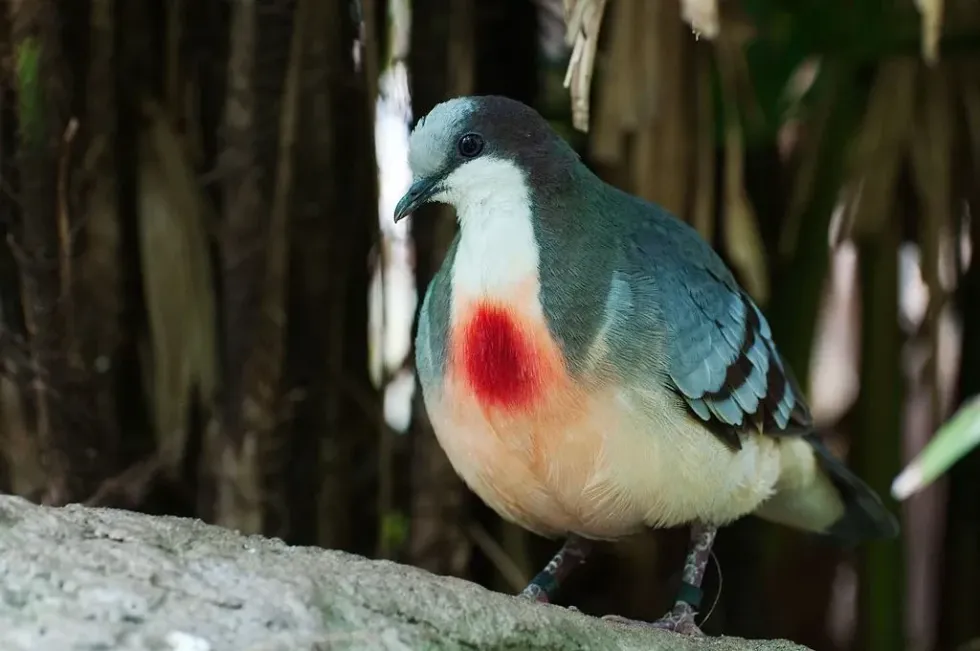The Mindoro bleeding-heart is a type of ground dove. It is endemic to the island of Mindoro in the Philippines. It is 9.8-11.8 in (25-30 cm) with a short tail and long legs.
It has a red patch on its white breast that looks like a bleeding heart. The males and females are hardly recognizable as they are similar in appearance. During the breeding season, the male attracts females using courtship display.
The female lays one to two eggs. The chicks are fed ‘crop milk.’ After 10-14 days, chicks leave their nest. The diet of this bird includes fallen berries and a variety of insects.
The Mindoro bleeding-heart is known for its quiet and secretive nature. The Mindoro bleeding-heart (Gallicolumba platenae) population is endangered. It is listed as the Near Threatened status under the IUCN red list.
Humans are the major reason for their extinction. Hunting of this dove is done for meat, trade, or marble extraction in the island area by the locals. Numerous conservation projects have been started to preserve this birdlife.
If you enjoy reading about the Mindoro bleeding-heart (Gallicolumba platenae), do check out interesting facts about the Eurasian collared dove and diamond dove.
Mindoro Bleeding Heart Interesting Facts
What type of animal is a Mindoro bleeding-heart?
These beautifully colored birds belong to the genus Gallicolumba and Columbidae family.
What class of animal does a Mindoro bleeding-heart belong to?
The Mindoro bleeding-heart is a type of bird from class Aves of Gallicolumba genus.
How many Mindoro bleeding-hearts are there in the world?
Their total population is estimated to be around 70-400. Their population has tremendously decreased in the past few years. They are considered a critically endangered species and their distribution in many areas has been decreased.
Where does a Mindoro bleeding-heart live?
Mindoro bleeding-heart (Gallicolumba platenae) birds are native to the north of the Philippines archipelago. They are usually found on the island of Mindoro. Nearby islands like Luzon and Polillo are also home to this species but their distribution is comparatively less in these islands.
What is a Mindoro bleeding-heart's habitat?
Their habitat includes lowland forest areas. They live in a dense area of agriculture and feed on the forest ground. Roosting and nesting are done in shrubbery and vines of medium height or less on the ground.
Who do Mindoro bleeding-hearts live with?
The Mindoro bleeding-heart forms a small flock for feeding and other activities. They are often found in a group with other wild dove families in forest areas.
How long does a Mindoro bleeding-heart live?
The life expectancy of bleeding-heart (Gallicolumba platenae) species is usually 15 years, but if they were to be in captivity for trade, they would live up to 20-25 yrs.
In recent years, the lifespan of this endangered birdlife has decreased as threats of getting killed in hunting have increased, meaning that the group of birds or their family lives in hiding out of fear in dense forest habitats and agriculture areas.
How do they reproduce?
The shy behavior of these animals has proven difficult to observe this dove species in their natural habitat, which makes studying their breeding behavior challenging. During breeding, males display courtship displays to attract females.
To fully display his blood markings or heart, the male chases the female, displaying an inflated breast. Males bow their heads and coo lovingly to their mates once they are smitten by the female.
Mid-May is considered the most likely time for nesting. Breeding pairs can reproduce throughout the year in captivity.
There are two creamy-white eggs laid by females.
The egg is incubated by both parents for 15-17 days; the female sits on the eggs during the day, and the male sits on them at night. Parents continue to feed the fledglings for up to a month after the young leave the nest, even though it has been 10-14 days since they left.
The chicks are fed crop milk. Within two to three months, the young will begin developing adult plumage and must be separated from the adults.
Those who are not successful with this process will often get attacked by their parents and get killed. When the juveniles reach 18 months of age, they go through a second molt that leads to sexual maturity.
What is their conservation status?
The Mindoro bleeding-heart (Gallicolumba platenae) is a critically endangered birdlife. It has been listed as the Near Threatened species in the IUCN red list. Its population size is estimated to be around 70-400. They are continuously decreasing in number every day.
Occasionally, they are hunted in a group in the forest habitat. Different organizations have taken part in many projects dedicated to saving and preserving this birdlife. It even has been featured in many local Philippines news for support and conservation practices.
Mindoro Bleeding-Heart Fun Facts
What do Mindoro bleeding-hearts look like?
This species is a type of ground dove. It is small, bulky in size, and weighs around 0.4 lb (184 g).
It has a short tail and long legs. Wings are blue-gray in color and have a whitish patch on their neck. A dark orange-red band is found on the wing coverts.
They have white breasts, throats, and underparts. Light pink and black feathers surround the patches of red on their breasts that resemble a bleeding wound. There are red marks on their legs and feet.
There are no obvious sexual differences between the sexes, and they are not sexually dimorphic species. Usually, some males appear to be larger than the females with a broader head, but still, they are unrecognizable.

*We've been unable to source an image of a Mindoro bleeding-heart and have used an image of a Luzon bleeding-heart instead. If you are able to provide us with a royalty-free image of a Mindoro bleeding-heart, we would be happy to credit you. Please contact us at hello@kidadl.com.
How cute are they?
These doves are very cute looking as they are a colorful species, have a small size and chubby look.
How do they communicate?
They are known as the quiet, secretive type of dove species. During the breeding season, they attract females with their courtship display. It chases after a female showing his exposed blood marking. And give a call during courtship.
How big is a Mindoro bleeding-heart?
They are 9.8-11.8 in (25-30 cm) in length. They are almost similar in size to Luzon bleeding heart species.
How fast can a Mindoro bleeding-heart fly?
This bird species can fly only a short distance, and the actual speed is unknown.
How much does a Mindoro bleeding-heart weigh?
This bird species weighs 0.4 lb (184 g).
What are the male and female names of the species?
There are no specific names given to different-sex species. They are called female Mindoro bleeding heart and male Mindoro bleeding heart. They are also called Kulo kulo or Lado or sometimes as Manated.
What would you call a baby Mindoro bleeding-heart?
The baby Mindoro bleeding heart is called a chick.
What do they eat?
These birds feed on seeds, fallen berries, insects, and worms from the ground. As they live in lowland wild forest regions, they mostly eat figs.
Are they dangerous?
No, this bird species is not dangerous. They are calm natured but when they are kept captive, they behave aggressively. Humans living near wild lowland forest areas or locals are among the threats to this species.
Would they make a good pet?
They are silent species, hunted for meat by the locals, and keeping them as pets seems impossible. The number of these birds is continuously decreasing regularly. Hunting is quite common for trade and meat in dense forest areas.
Did you know...
Their known predators are mammals, reptiles, and birds of other species. They include hawks, eagles, vultures, snakes, owls, crocodiles, and monkeys found in the forest areas of the Philippines.
These bird species are known for being of small size, quiet, and shy nature. While breeding season, they court females with a soft 'co-co-cooooo' to attract them.
This species is now critically endangered, the main reasons for their extinction risk being lowland forest deforestation, humans captivating them for food, and an increase in cities population. Mindoro bleeding-heart conservation projects have been started by NGOs to keep them safe.
Why are Mindoro bleeding-hearts called so?
This bird is called so because it has a red-colored patch on the white breast near the heart that looks like blood. They are found on the island of Mindoro and, therefore, the name Mindoro.
What is the role of the Mindoro bleeding-heart?
Local ecology and biodiversity are greatly influenced by these birds. Using seed dispersal, this bird species helps to ensure successful forest growth. Many endemic species and rare species can be found on the island Mindoro, which are among the top 10 biodiversity hotspots in the world.
Landslides and soil erosion are prevented by these habitats. They are a key to maintaining the island's natural ecosystem. Hunting of these endangered birds for food and trade is common.
Here at Kidadl, we have carefully created lots of interesting family-friendly animal facts for everyone to discover! Learn more about some other birds from our Inca dove facts and pigeon facts pages.
You can even occupy yourself at home by coloring in one of our free printable Mindoro bleeding-heart coloring pages.









